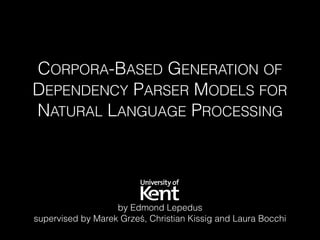
CO620
- 1. CORPORA-BASED GENERATION OF DEPENDENCY PARSER MODELS FOR NATURAL LANGUAGE PROCESSING by Edmond Lepedus supervised by Marek Grześ, Christian Kissig and Laura Bocchi
- 2. BACKGROUND
- 4. Dependency Parsing • Structure consists of dependencies between words:
- 5. Dependency Parsing • Structure consists of dependencies between words: Hello world
- 6. Dependency Parsing • Structure consists of dependencies between words: Hello world dependent
- 7. Dependency Parsing • Structure consists of dependencies between words: Hello world headdependent
- 9. Stanford CoreNLP • Free, open-source NLP toolkit
- 10. Stanford CoreNLP • Free, open-source NLP toolkit • Includes a dependency parser backed by a neural network classifier
- 11. Stanford CoreNLP • Free, open-source NLP toolkit • Includes a dependency parser backed by a neural network classifier • Parses 1000 sentences per second at 92.2% accuracy:
- 12. Stanford CoreNLP • Free, open-source NLP toolkit • Includes a dependency parser backed by a neural network classifier • Parses 1000 sentences per second at 92.2% accuracy:
- 13. Stanford CoreNLP • Free, open-source NLP toolkit • Includes a dependency parser backed by a neural network classifier • Parses 1000 sentences per second at 92.2% accuracy: • Trained on manually annotated text
- 14. AIM
- 15. Aim Train a classifier using an unparsed corpus of English language text
- 16. MOTIVATION
- 17. Motivation
- 18. Motivation • Decrease the cost of training data
- 19. Motivation • Decrease the cost of training data • Increase the availability of training data
- 20. Motivation • Decrease the cost of training data • Increase the availability of training data • Increase parsing accuracy
- 21. Motivation • Decrease the cost of training data • Increase the availability of training data • Increase parsing accuracy • Enable the parsing of languages with few remaining speakers
- 22. APPROACH
- 23. Overview
- 24. Overview 1. Create a ‘blank’ model
- 25. Overview 1. Create a ‘blank’ model 2. Parse corpus with model & log decisions
- 26. Overview 1. Create a ‘blank’ model 2. Parse corpus with model & log decisions 3. Extract heuristics from corpus & parse log
- 27. Overview 1. Create a ‘blank’ model 2. Parse corpus with model & log decisions 3. Extract heuristics from corpus & parse log 4. Generate training examples by modifying the logged decisions to fit the discovered heuristics
- 28. Overview 1. Create a ‘blank’ model 2. Parse corpus with model & log decisions 3. Extract heuristics from corpus & parse log 4. Generate training examples by modifying the logged decisions to fit the discovered heuristics 5. Train model on new examples
- 29. Diagram Create a ‘blank’ model Parse & log Extract heuristics Generate training examples Train new model
- 30. IMPLEMENTATION
- 32. Blank Model Creation • Outputs left arcs with custom ‘unknown’ label:
- 33. Blank Model Creation • Outputs left arcs with custom ‘unknown’ label:
- 34. Blank Model Creation • Outputs left arcs with custom ‘unknown’ label: • Supports the creation of new training examples
- 36. Parse Decision Logs • Log every parse decision to YAML:
- 37. Parse Decision Logs • Log every parse decision to YAML:
- 38. Parse Decision Logs • Log every parse decision to YAML: required for training
- 40. Heuristic Extraction • Count bigram occurrences:
- 41. Heuristic Extraction • Count bigram occurrences:
- 42. Heuristic Extraction • Count bigram occurrences: • Assume that frequent bigrams indicate dependency
- 48. RESULTS
- 52. FURTHER WORK
- 53. Further Work
- 54. Further Work • Improve efficiency to enable the use of larger corpora
- 55. Further Work • Improve efficiency to enable the use of larger corpora • Develop better heuristic analyses
- 56. Further Work • Improve efficiency to enable the use of larger corpora • Develop better heuristic analyses • Implement arc labels
- 57. CONCLUSION
- 58. Conclusion
- 59. Conclusion • We modified the Stanford CoreNLP toolkit to enable the creation of ‘blank’ parser models
- 60. Conclusion • We modified the Stanford CoreNLP toolkit to enable the creation of ‘blank’ parser models • We developed a workflow for training parser models without using annotated corpora
- 61. Conclusion • We modified the Stanford CoreNLP toolkit to enable the creation of ‘blank’ parser models • We developed a workflow for training parser models without using annotated corpora • We showed that this quickly yields qualitative improvements in parser outputs over the ‘blank’ models
- 62. Conclusion • We modified the Stanford CoreNLP toolkit to enable the creation of ‘blank’ parser models • We developed a workflow for training parser models without using annotated corpora • We showed that this quickly yields qualitative improvements in parser outputs over the ‘blank’ models • We proposed three avenues for further research
- 63. ANY QUESTIONS?
- 64. REFERENCES [1] C. Manning, M. Surdeanu, J. Bauer, J. Finkel, S. Bethard, and D. McClosky, “The Stanford CoreNLP Natural Language Processing Toolkit,” presented at the Proceedings of 52nd Annual Meeting of the Association for Computational Linguistics: System Demonstrations, Stroudsburg, PA, USA, 2014, pp. 55–60. [2] J. Nivre, “Dependency Parsing,” vol. 4, no. 3, pp. 138–152, Mar. 2010. [3] D. Chen and C. D. Manning, “A Fast and Accurate Dependency Parser using Neural Networks.,” EMNLP, pp. 740–750, 2014. [4] D. Jurafsky and J. H. Martin, Speech and language processing: an introduction to natural language processing, computational linguistics, and speech recognition. Upper Saddle River, NJ: Prentice-Hall, 2000.